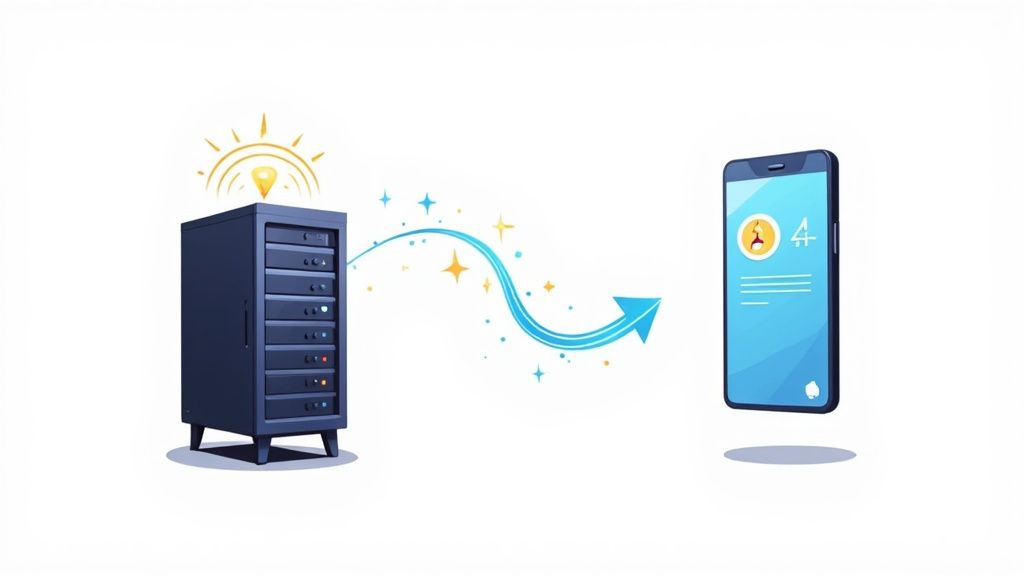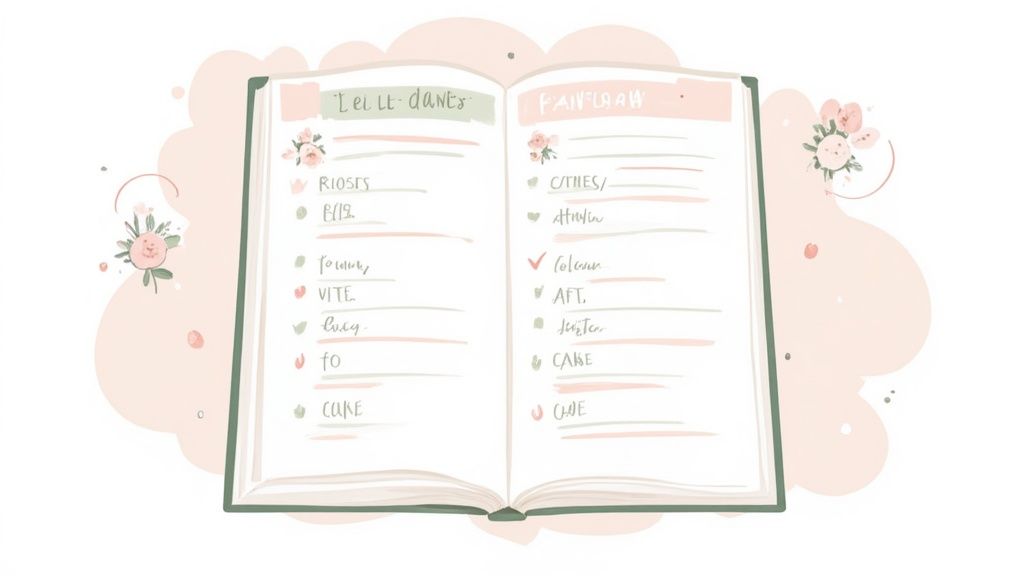At its core, a webhook is just an automated message sent from one application to another when a specific event happens. Think of it as a real-time notification system that lets different software communicate instantly, without you needing to lift a finger.
What Are Webhooks? A Simple Analogy
To really get what webhooks are all about, let's ditch the technical jargon for a second and think about ordering food.
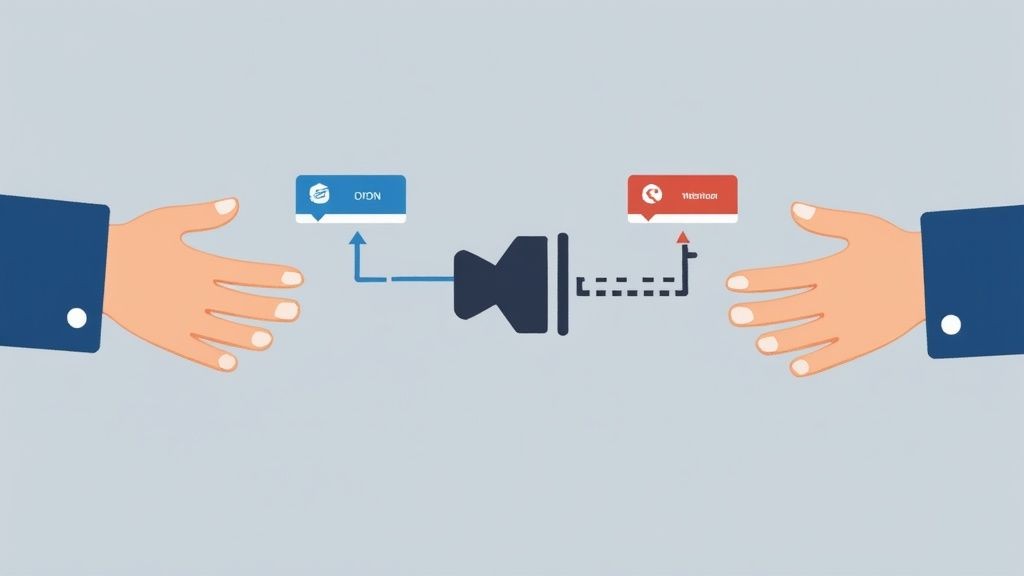
Imagine you're at a restaurant. One way to check on your order is to keep walking up to the counter and asking, "Is my food ready yet?" over and over. This is exactly how traditional API polling works. It gets the job done, sure, but it’s repetitive and inefficient for both you and the kitchen staff.
Now, picture a different scene. You place your order, and the restaurant hands you a buzzer. You can go back to your table and relax. The second your food is ready, the buzzer lights up and vibrates. That’s a webhook.
Instead of your application constantly asking for new information (polling), the other service sends - or "pushes" - the information to you the exact moment it's available. This "push" model is what makes webhooks a cornerstone of modern automation.
Webhooks vs. API Polling at a Glance
The real difference between these two methods boils down to efficiency and timing. One is reactive, while the other is proactive. To make it crystal clear, here’s a quick comparison.
This table breaks down the fundamental differences between the "push" model of webhooks and the "pull" model of API polling.
| Feature | Webhooks (Push Model) | API Polling (Pull Model) |
|---|---|---|
| Data Flow | The server sends data automatically when an event occurs. | The client must repeatedly request data from the server. |
| Efficiency | Highly efficient; uses server resources only when there's new data. | Less efficient; consumes resources with every request, even if nothing has changed. |
| Timeliness | Delivers information in real-time, enabling instant actions. | Data delivery is delayed by the polling interval (e.g., every 5 minutes). |
| Best For | Instant notifications, event-driven workflows, and real-time updates. | Non-urgent data syncs or when a service simply doesn't offer webhooks. |
As you can see, webhooks are built for speed and efficiency, which is what makes them so powerful for building connected, automated systems.
This real-time capability is a game-changer. For instance, with our service, you can use webhooks to get notified the instant someone adds an event to their calendar. For a deeper dive into the technical side of things, you can explore the details in our webhook API documentation.
How a Webhook Delivers Information
So, how does a webhook actually get information from point A to point B? Think of it like a package being shipped directly to your door. It’s a clean, straightforward process where the information is bundled up and sent to a specific address the instant something happens.
Let's trace this journey, piece by piece.
This simple infographic breaks down the three main stages, from the initial trigger to the final automated action.
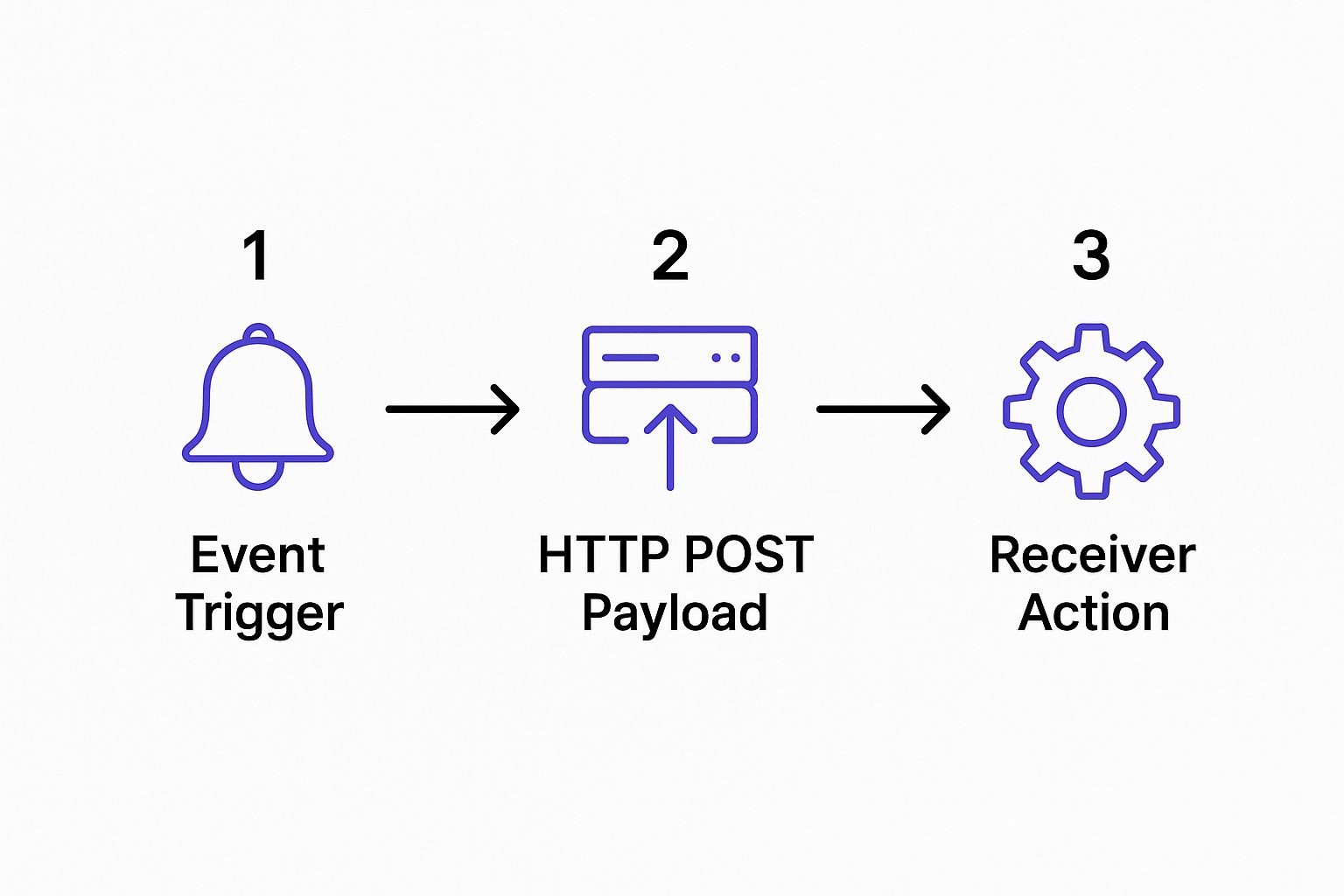
You can see the flow is beautifully simple: an event kicks things off, the data is sent out, and the receiving system takes care of the rest. This direct line of communication is exactly what makes webhooks so incredibly efficient for real-time automation.
The Event Trigger: The Starting Signal
It all starts with an event trigger. This is just a specific, pre-defined action that tells the source application, "Hey, something important just happened. Time to send an update." It's the "buzzer goes off" moment in our restaurant analogy.
An event trigger can be almost anything, depending on the service. A few common examples include:
- A customer finalizes a purchase on your e-commerce store.
- Someone posts a new comment on your blog.
- A guest RSVPs to an event using our service, Add to Calendar PRO.
When one of these triggers occurs, the source system knows it’s time to notify another application.
The Webhook URL: The Destination Address
For that notification to land in the right place, it needs a destination. That's where the webhook URL (sometimes called an HTTP endpoint) comes in. You give this unique URL to the source app when you’re setting things up. It’s like giving the restaurant your exact table number so they know precisely where to bring your food.
This URL is special because it’s built to "listen" for incoming data. When the source system sends its message, it's aimed directly at this address. Your receiving application is then responsible for keeping an ear out at this endpoint, ready to catch any information that arrives.
The Data Payload: The Message Itself
As soon as the trigger event happens, the source app gathers up all the relevant information into a neat little package called a payload. This payload is the actual data being sent from one system to another. It's usually formatted in JSON (JavaScript Object Notation) because it’s lightweight and incredibly easy for different applications to understand.
A payload is the "what" of the webhook communication. It contains the specific details about the event that just occurred, allowing the receiving application to understand and act on the information without needing to ask for more context.
For example, if someone RSVPs to your event, the payload might contain their name, email, and which event they signed up for. This bundle of data is then sent to your webhook URL using an HTTP POST request - the standard web method for sending data to a server. Your application receives this payload, unpacks it, and uses that fresh information to kick off the next step in your automated workflow.
Real-World Examples of Webhooks in Action
Okay, the theory behind webhooks is one thing, but seeing them work in the real world is where their power really clicks. Think of webhooks as the invisible threads connecting all the digital services you use every day, creating slick, automated experiences that happen in the blink of an eye. They're the secret sauce working behind the scenes to keep your favorite apps in sync.
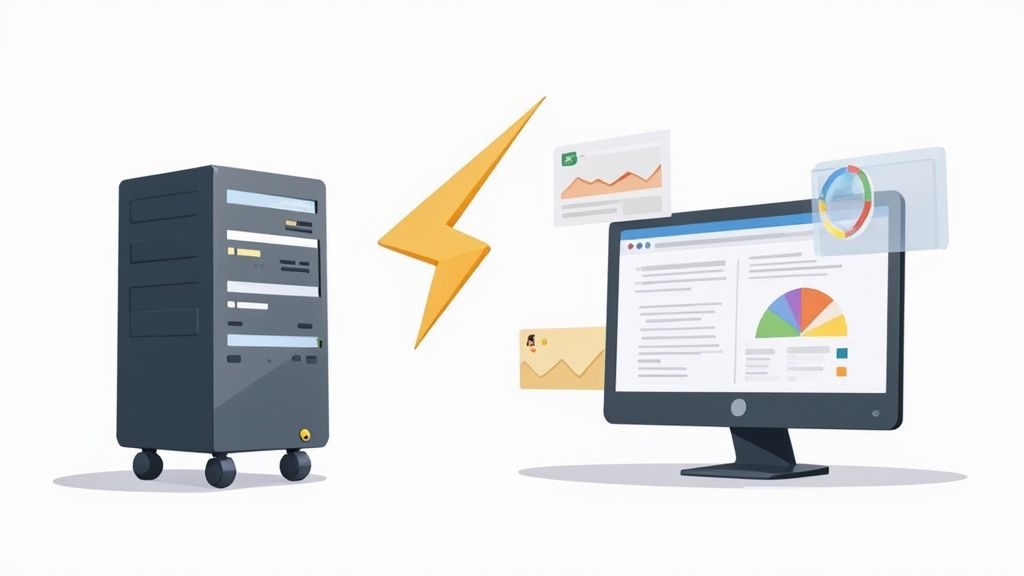
This kind of event-driven communication has pretty much become the standard for modern software. The 2024 State of Webhooks report, which looked at the world's top 100 APIs, found that a whopping 85% now support webhooks. That number tells you everything you need to know - the industry is all-in on real-time notifications for making things more efficient. You can dig into the full report for more insights on the growth of webhooks on hackernoon.com.
Let's break down a few common scenarios where webhooks are making a huge difference.
Powering E-Commerce and Development Workflows
In the fast-paced worlds of online shopping and software development, speed and accuracy are non-negotiable. Webhooks are the backbone that keeps these complex systems humming along without someone needing to manually push buttons.
Here are a couple of classic examples:
- Instant Order Fulfillment: The moment a customer hits "Buy Now" on a Shopify store, a webhook can fire off a notification to the shipping system. That single event can trigger an inventory update, print a shipping label, and send the customer a confirmation email - all before they've even closed the tab.
- Real-Time Code Updates: When a developer pushes a new batch of code to a repository on GitHub, a webhook can instantly ping the team's Slack channel. This keeps the whole team in the loop and can even kick off an automated deployment process.
In both cases, a single event sets off a domino effect of automated tasks, saving a ton of time and cutting down on the risk of human error.
Elevating Event Management with Add to Calendar PRO
For anyone marketing an event, getting real-time data is gold. It's crucial for engagement and planning, and this is where webhooks really shine, especially when you pair them with our service, Add to Calendar PRO.
Imagine you're promoting a webinar. When someone clicks your "Add to Calendar" button and adds the event, a webhook can be sent to your system that very instant. This isn't just a simple notification; it's a trigger for a whole chain of automated actions.
By connecting our service to your other tools via webhooks, you can build a responsive, automated system that engages attendees from the moment they show interest. This turns a simple calendar addition into a valuable marketing touchpoint.
With this kind of setup, you could instantly:
- Update Your CRM: Add the person to an "Attendees" list in your customer relationship management software.
- Send a Welcome Email: Tell your email marketing platform to send a personalized welcome message with event details and helpful resources.
- Notify Your Team: Post a message in a dedicated Slack channel to let everyone know a new person has signed up.
This immediate, automated follow-up creates a professional and engaging experience for your audience right from the start. To get going with these powerful integrations, you can check out our detailed guide on setting up webhooks with Add to Calendar PRO.
Why Bother With Webhooks? The Payoff is Huge.
So, why are so many modern apps and services built around webhooks? It really boils down to the massive advantages they have over older methods like polling. This isn't just a technical detail for developers to geek out over; using webhooks leads to better experiences for your users, lower costs for your business, and systems that are way more powerful and connected.
The core benefits are simple but incredibly impactful. Webhooks give you information the second it's available, they run with amazing efficiency, and they make it much easier to build the kind of dynamic, responsive applications people expect today.
Let's break down what that actually means for you.
Instant Data for Real-Time Everything
The biggest win with webhooks is instant data delivery. The very moment something happens in one system - a payment goes through, a new lead fills out a form, a ticket is updated - that information is immediately pushed to your application. There's no lag. No waiting around for the next scheduled check-in.
This real-time communication is what separates a clunky user experience from a great one. When a customer buys something, they expect a confirmation email right away, not five minutes later. Webhooks make that instant feedback loop possible, which builds trust and keeps your users in the know.
Goodbye, Wasted Resources. Hello, Efficiency.
Beyond just speed, webhooks are ridiculously resource-efficient. Think back to our API polling analogy - the one where your app is constantly asking the server, "Anything new? How about now? Is it ready yet?" Every single one of those requests eats up server resources, bandwidth, and processing power, even when the answer is "nope." Over time, that adds up to a serious drain on your infrastructure and your budget.
Webhooks cut out all that waste.
Because a webhook only fires off a request when there's an actual event to report, it slashes unnecessary server traffic. This efficiency translates directly into lower server costs and less strain on your systems, letting your applications run leaner and scale up without breaking a sweat.
A Simpler Way to Build Modern Apps
Finally, webhooks are the secret sauce behind a modern event-driven architecture. This is a fancy way of saying you can build systems that react to events as they happen, instead of just running on a dumb, fixed schedule. Rather than writing complex code to constantly check for changes, you can create simple, focused services that just listen for a specific webhook and then do one specific job.
This approach isn't just simpler to build and maintain; it makes your applications far more dynamic and powerful. With our service, for example, a single "add to calendar" event can trigger a webhook that instantly updates your CRM, sends a personalized welcome email, and pings your team on Slack. All of this happens automatically, without the tangled mess of a polling-based system. It’s how you create powerful, automated workflows that are both robust and surprisingly easy to manage.
Essential Webhook Security Practices
Once you start using webhooks, you get all the power of real-time automation. But with that power comes a serious responsibility: you have to protect those data streams.
Think about it: a webhook URL is just a public endpoint. Anyone who finds it could bombard your application with junk data or, even worse, malicious payloads. Securing this endpoint isn’t just a good idea; it's absolutely critical for keeping your data clean and preventing unauthorized actions.
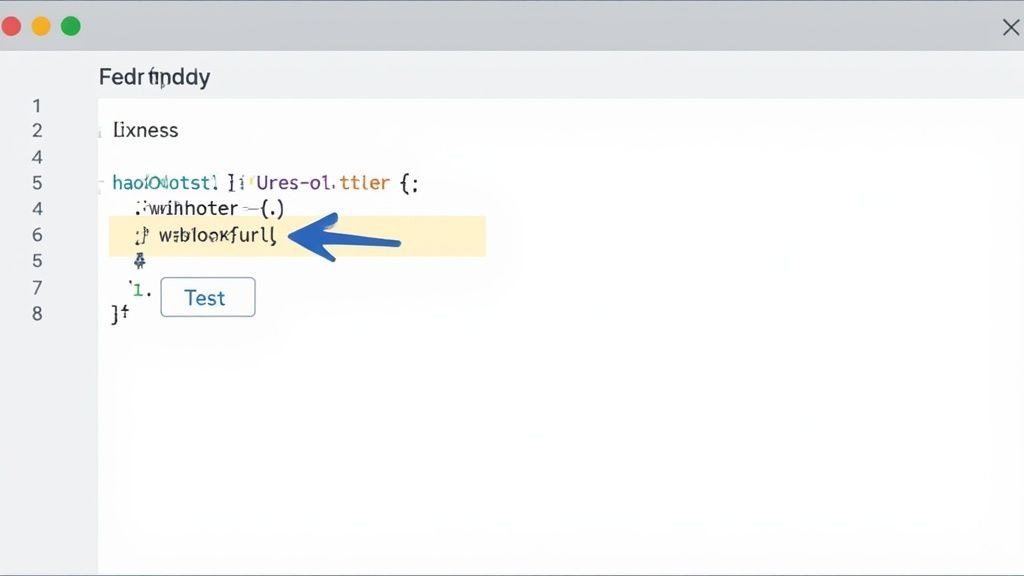
This isn't just a niche concern, either. As more companies build their systems around these event-driven notifications, security has become a massive focus. The market for SaaS webhook security is expected to grow at a compound annual rate of 18.6% between 2025 and 2033, ballooning to an estimated $6.15 billion. This tells you everything you need to know about how important robust security is becoming. You can dig into more of the numbers from Growth Market Reports.
Luckily, you don't need to be a security guru to lock things down. A few key practices will safeguard your systems and let you use webhooks with complete confidence.
Verify Signatures to Confirm Authenticity
This is the single most important thing you can do. Signature verification is like a secret handshake between the sending service and your application.
Here’s how it works: when you set up the webhook, both systems agree on a secret key that only they know. From then on, every single payload sent by the source comes with a unique signature. This signature is created by combining the payload data with that secret key.
When your application receives the webhook, it runs the exact same calculation. It takes the payload it received, combines it with the secret key it has stored, and compares the result to the signature that came in the request.
If the signatures match, you can be 100% certain the request is legit and came from the right place. If they don't, you should toss it out immediately. It could have been tampered with or sent by an imposter.
Encrypt Data with HTTPS
Using HTTPS for your webhook URL is completely non-negotiable. It's table stakes for modern web development.
An old-school, unencrypted HTTP connection sends everything in plain text. That means anyone snooping on the network traffic can read it all.
By sticking with an HTTPS endpoint, you guarantee the entire payload is encrypted from the moment it leaves the sender until it arrives safely at your server. This shields sensitive information from prying eyes and shuts down "man-in-the-middle" attacks, where a bad actor could intercept and even change the data on its way to you.
Design for Idempotency and Retries
The internet isn't perfect. Connections drop, servers get busy, and things go wrong. Because of this, a webhook provider will sometimes send the same event more than once just to make absolutely sure you received it. This is called a retry.
If your system isn't built to handle this, you could be in for a world of hurt. Imagine charging a customer twice for the same purchase or spamming a user with the same notification three times in a row. Not good.
The solution is to design your system to be idempotent. It’s a fancy word for a simple concept: processing the same request multiple times has the exact same result as processing it just once. You can pull this off by giving each event a unique ID. Before you take any action, you just check if you've already processed an event with that ID. If you have, you can safely ignore it.
For more tips on building resilient systems like this, take a look at our guide on API integration best practices.
Frequently Asked Questions About Webhooks
Even after getting the hang of the basics, a few common questions always seem to pop up when people start digging into webhooks. This is where we'll tackle those lingering queries, clearing up the final details so you can start putting this powerful tech to work.
We’ll break down the key differences between webhooks and APIs, talk about how hard they really are to set up, and pinpoint exactly when you should use one over the other.
What Is the Main Difference Between an API and a Webhook?
The biggest difference boils down to one thing: who starts the conversation.
Think of a standard API as a "pull" system. Your app has to constantly reach out to a server and ask, "Hey, got anything new for me?" It's a repetitive cycle of checking for updates, often on a set schedule.
A webhook, on the other hand, is a "push" system. The moment a specific event happens, the server automatically pushes the data straight to your application. No asking needed - the information just shows up when it's ready.
In simple terms: with an API, you call them. With a webhook, they call you. This little switch from pulling to pushing is what makes webhooks so incredibly efficient.
Instead of your app bugging a server every five minutes to check for a new customer signup (the API way), a webhook tells your app about the new customer the second it happens.
Are Webhooks Difficult to Implement?
Honestly, it really depends on the service you're using and what you're trying to do. Many modern platforms, including our service, have made setting up webhooks ridiculously simple. Often, it's as easy as copying a unique URL from one app and pasting it into a settings field in another.
The trickier part is having a destination - an endpoint - on your end that's ready to catch and process the incoming data. But even that doesn't mean you need to be a developer anymore.
There are tools that bridge this gap beautifully:
- No-Code Platforms: Services like Zapier, Make, or n8n can act as a middleman. You give them the webhook URL, and they catch the data for you, letting you build out automated workflows with a simple drag-and-drop interface. No coding required.
- Simple Listeners: For the more technically inclined, setting up a basic listener is a pretty standard task. A small, dedicated script can be written to accept the incoming data and kick off another action, like updating a database or sending a Slack alert.
So, while a super-custom, complex integration might get technical, a huge number of powerful webhook use cases are now within reach for just about everyone.
When Should I Use a Webhook Instead of Polling?
The choice between a webhook and polling really comes down to one thing: urgency.
You should use a webhook whenever your application needs to react to something in real-time. If waiting around for the next scheduled check is too slow or inefficient, a webhook is your best bet. It’s perfect for moments like:
- A payment is successfully processed.
- A new user signs up.
- A customer support ticket gets an update.
- Someone adds your event to their calendar.
Polling, however, still has its place. It’s a better fit for non-urgent tasks where data just needs to be synced up every so often. Think about generating a daily sales report or running a nightly data backup - neither needs instant, up-to-the-second information. Polling is also your only option if the service you’re using just doesn't offer webhooks.
But for any workflow that thrives on speed and efficiency, webhooks are almost always the right answer.
Ready to build smarter, real-time workflows for your events? With Add to Calendar PRO, you can use webhooks to instantly connect your calendar events to your favorite CRM, email marketing platform, or team chat. Start automating your event management today.
